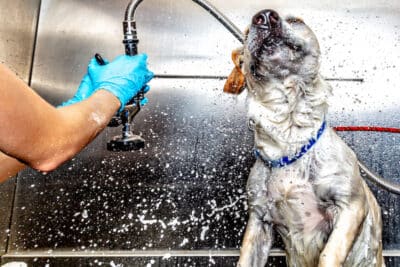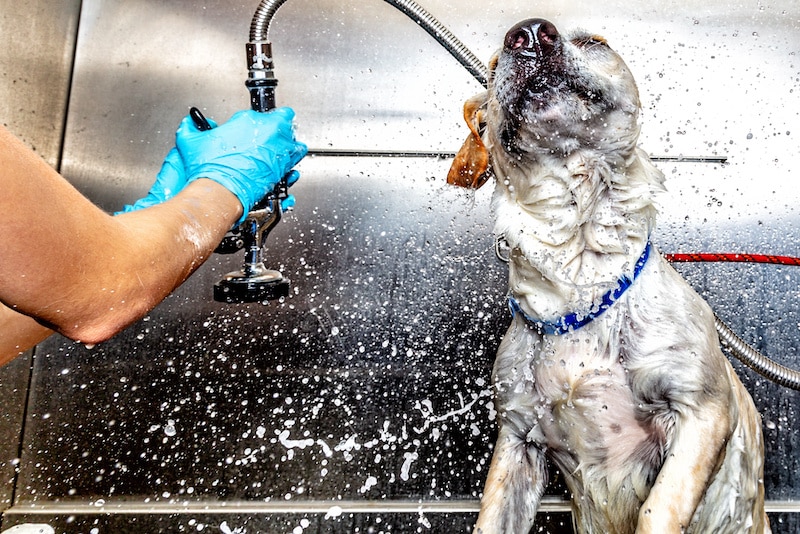Rottweilers are loyal, hard working, courageous dogs. And while some may find them intimidating, they’re actually among the sweetest, most loving family companions in dogdom.
Do they shed lots?
Rotties have a dense, medium-length double coat that sheds moderately throughout most of the year, but you may notice an increase in shedding during spring and fall as they “blow coat.”
So they’re not ideal if you’re looking for a low shedder, but the molting is fairly easy to manage with regular brushing.
In this article, we’ll discuss how much hair you should expect to see floating around the home, what they’re like to groom and how to manage the shedding, so you know what to expect.
Recommended: Go here to see our top-rated dog hair blow dryers
About Rottweilers
The Rottweiler’s lineage dates all the way back to the Roman Empire, where their strong, hard working mastiff type ancestors (Roman drover dogs) were used to drove and guard livestock.
After the collapse of the Empire, Roman drovers found their way to the German cattle town of Rottweil, where they drove and guarded cattle, protected their masters, and hauled butcher’s carts while travelling between farms and markets. Safe to say, they earned their keep! And eventually this prized breed became known as the “Butcher’s Dog of Rottweil.”

Over time, however, with the introduction of the railroad system in the 19th century, Rotties needed to branch out and put their talents to work in other ways. Which is what they did. Over the years, they’ve been employed as police dogs, guides for the blind, guard dogs, and other working roles that prove just how versatile and dependable they are.
And in 1931, they were officially registered with the American Kennel Club as the Rottweiler. Today, they’re best known as powerful, loyal guardians as well as gentle, loving companions, and they’re among the top ten most popular dog breeds in the United States.
Rottweiler Shedding – What to Expect
Rottweilers are a moderate-to-high shedding breed.
Throughout most of the year, they drop a moderate amount of fur, but during shedding season this tends to increase and can become quite noticeable.
Shedding is normal among most healthy dogs, especially those with undercoats, which Rotties have. It’s part of the natural hair growth cycle where hair grows (anagen), stops growing (catagen) and eventually falls out to be replaced by new hairs (telogen).
But some breeds have a faster hair growth cycle than others.
For example, the Afghan Hound has a fairly slow hair growth cycle, so their hair tends to grow longer and they shed at a lower rate. While dogs like the Rottie, Labrador and German Shepherd have much faster hair growth cycles and therefore shed more.
It’s also normal for dogs to shed seasonally. Seasonal shedding is simply a dogs way of adapting to the changing seasons. For example, Rotties tend to molt their winter coat in spring, as they no longer need their thicker winter coat in the coming summer months. And the same is true in fall (autumn), where they shed their summer coat to grow in a thicker winter coat.
How extreme this seasonal “coat blow” is really depends on the breed and individual dog, among other factors such as the climate they reside in. But either way, you should expect to notice more fur falling out at least once or twice per year for two-to-four weeks at a time.
In some cases, excessive shedding can be cause for concern. For instance, if your dog has fleas, allergies, is stressed or has some other health problem, they may shed more. So if you have any concerns, it may be a good idea to contact a veterinarian.
Rotties do molt though, so in most cases it’s normal.
And thankfully, they’re not the heaviest shedder out there. But they’re also not ideal for those wanting a “non-shedding” or “hypoallergenic” dog either. So if you can’t stand seeing dog fur around the home, or have pet allergies, you may prefer an alternative breed.
Recommended: Go here to see our top-rated dog hair blow dryers
Coat and Grooming
The Rottie’s double coat consists of both an outer coat and undercoat.
The outer coat is straight, coarse, medium-length outer coat that is black and either tan, rust or mahogany. And the undercoat is soft and normally located around the neck and thighs.
The good thing about this coat is that it’s fairly low maintenance, which is the way it should be for a working dog, and it helps keep him insulated from both cold and hot weather conditions.
So you generally only need to brush your Rottie once or twice a week with a slicker brush or bristle brush to maintain his coat. Which are both simple, inexpensive dog brushes.
The slicker brush is a brush made up of fine wire bristles, with plastic tips on the ends, that are angled in such a way that helps remove the dead fur.
The bristle brush won’t reach as far down to the skin as a slicker, so it’s not as effective at removing the dead fur, but it is a good brush to have on hand for general brushing and for adding shine to his coat.
During shedding season, brushing once a week probably won’t cut it, and you may find that using a deshedding tool will save you some time and effort, since these are designed to remove as much dead fur as possible, in the least amount of time.
Bathing is also important as a good quality dog shampoo can remove a lot of the old fur, help maintain his coat, and keep him smelling good. As with brushing, you shouldn’t overdo this, otherwise you risk drying out their skin and causing the shedding to worsen.
Can you shave a Rottie?
Rotties have a double coat that helps insulate them from weather extremes (hot and cold) and helps protect them from things like sunburn, windburn and mosquitos. So shaving is not recommended unless your vet specifically recommends it for a medical reason, as it exposes them to the very things their coat helps protect them from.
Do Rotties have hair or fur?
On one hand, hair and fur are the same on a chemical level, they are both made from a protein called keratin. So for the most part, the difference is that the term “fur” is used to describe dog hair, while human hair is described as “hair.”
On the other hand, some argue that there is a difference between hair and fur in the way it grows. Basically, the argument is that hair takes longer to grow (as in it has a longer growth cycle) than fur and therefore, dogs with “hair” shed less.
Assuming the latter argument is true, then I guess you could argue that Rotties have fur because their coat has a short growth cycle in comparison to many longer-haired, lower shedding dogs, such as the Silky Terrier or Poodle for example.
Do Rottweilers drool much?
Like most dogs, Rotties do drool. How much they drool, however, depends on the individual dog and things like whether or not they are hungry or thirsty, if they’ve just finished exercising, if they’re hot or just finished a big drink of water. Overall, they generally don’t drool as much as an English Mastiff, but they tend to drool more than dogs like the Doberman.
Reducing Excessive Shedding
It’s not possible to completely stop your Rottweiler from shedding, but there are some very effective ways of reducing excessive shedding, and managing it so that the least amount of fur possible fills your home, and you can spend the least amount of time possible vacuuming.
And there are basically three main ways you can do this:
- Nutrition: Making sure your Rottie is eating properly is at the top of the list for a reason, what they eat can make a big difference to their overall health and wellbeing, as well as the condition of their coat and, in turn, how much they shed. Speak with your vet about selecting a high quality dog food, and preferably one that contains healthy Omega-3 fatty acids, as this can make a big difference.
- Grooming: Brushing and bathing are the next best ways to manage the shedding. Firstly because brushing helps distribute the skin oils of your dog and secondly because the more fur you can remove before it drops off of his coat, the better. As with most things, consistency is key and it’s important not to brush or bathe too often, otherwise you risk irritating or drying out your Rottie’s skin.
- Vacuuming: Once you’ve got the first two elements dialed in, the best thing you can do to keep your home fur-free is to vacuum often. And while you don’t need to buy an expensive vacuum cleaner, some are better than others and will be more able to withstand the sheer volume of fur you’ll be picking up.
Some people also use natural supplements and home remedies, like coconut oil for example, to help control the shedding. But proper nutrition, grooming and vacuuming are the most important elements to managing the shedding, and the good news is, they’re not difficult. It’s more just a matter of factoring these into your routine and staying consistent.
Bottom Line
Rottweilers are one of the most popular dogs in the world, and it makes sense when you consider how amazing they are. And even though they do molt, it’s not hard to manage with regular brushing, which is fairly easy to do with a Rottie given his coat.
So you can enjoy the company of this loyal, loving family companion without having a home that is constantly full of dog fur and without spending countless hours vacuuming.













Please note: By submitting a comment using the above comment form, you confirm that you agree with the storage and handling of your data by this site as detailed in our Privacy Policy.